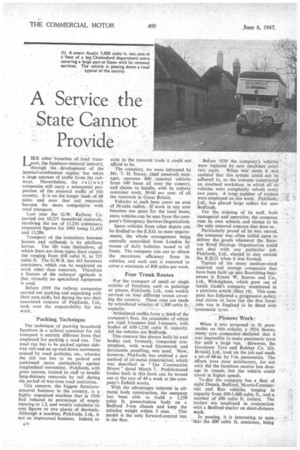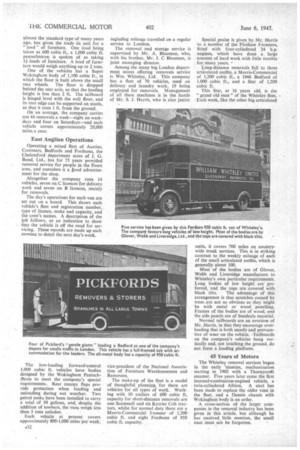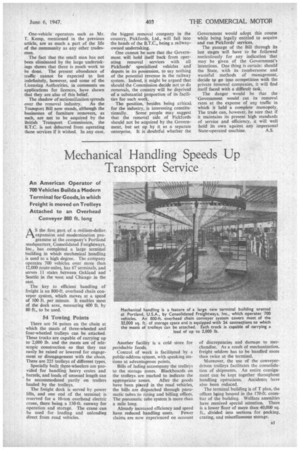A Service the State Cannot Provide
Page 32

Page 34

Page 35

If you've noticed an error in this article please click here to report it so we can fix it.
LIKE other branches of. i'oad transport, the furniture-removal industry, through the. development of the internal-combustion engine, has taken a large amount of traffic from the railways. Nevertheless, the railwa y companies still carry a substantial proportion of the removal traffic of this country. It is on the longer leads of. 60 miles and over that rail removals become the more, competitive with road transport.
Last year the GM. Railway Co. carried out 10,237 household removals, involving the use of 11,256 'containers, respective figures for 1945 being 11,435 and 13,286.
Transport of the containers between houses and railheadsis by platform lorries. The lift vans themselves, of which there are three types, have capacities ranging from 650 cubic ft. to 735 cubic ft. The G.W.R. has 163 furniture containers, which can be employed on work other than removals. Therefore a feature of the railways' niethods is that virtually no specialized equipment is used.
Before 1939 the railway companies carried out packing and unpacking with their own staffs, but during the war their associated concern of Pickfords, Ltd., took over the responsibility for this work. .
Packing. Technique The technique of packing household furniture in a railway container for rail transport is entirely different from that employed for packing a road van. The road van has to be packed against sideway roll.and an up-and-down movement caused by road potholes, etc., whereas the rail van has to be packed and cushioned more particularly against longitudinal movement. Pickfords, with great success, trained its staff to handle long-distance removals by rail during the period of war-time road restriction.
This concern, the biggest furnitureremoval business in the country, is a highly organized machine that in 1939 had reduced its percentage of empty running, to 1.2, and weekly calculates its cost figures to two places of decimals. Although a machine, Pickfords, Ltd., is not an impersonal business. Indeed, to AM! exist in the removal trade it could not afford to be.
The company, we were informed by Mr. T. H. Stacey, chief removals manager, operates 400 removal vehicles from 140 bases all over the country, and claims to handle, with its railway container work, 50-60 per cent, of all the removals in Great Britain.
Vehicles at each base cover an area of 30-mile radius. , If work in any area becomes too great for the local bases, extra vehicles can be sent from the company's Emergency Services Organization.
Spare vehicles from other depots can be drafted to the E.S.O. to meet requirements, the whole arrangement beitig centrally controlled from London by means of daily bulletins issued to all bases. The company sets out to obtain the maximum efficiency from its vehicles, and each unit is expected to cover a minimum of 800 miles per week.
Four Trunk Routes For the transport of small or single articles of futniture, such as paintings or pianos, Pickfords, Ltd., runs weekly services on four different routes covering the country. These runs are made by articulated vehicles of 1,500 cubic ft.
-capacity. _ -Articulated :outfits.form a third-of the company's fleet, the remainder. of which are rigid 3-tortners 'and 5-tonners, with bodies 'of 650-1,250 cubic ft. capacity. Al the vehicles are Bedford& This concern has always built its-own bodies and, formerly, .composite eonstruttion, with wood framework and duralumin panelling,was used. Now,.' however, -Pickfords has evolved a new method of all-metal cohstrUction, which' was described in "The Commercial Motor" dated March 7. Prefabricated: bodies built in this form can be turned out at the rate of 40 a week at the company's Enfield works,
With the advantages inherent in allmetal body construction, the company has been able to build a 1,250 cubic ft. pantechnicon body on a Bedford 5-ton chassis and keep the unladen weight within 3 tons. This model is the only forward-control van in the fleet.
Before 1939 the company's vehicles were replaced by new machines every two years. When war came it was realized that this system could not be adhered to, so the concern constructed : an overhaul workshop, in which all its vehicles were completely rebuilt every two years. A large number of women were employed on this work. Pickfords. Ltd., has placed large orders for new Bedfords.
For the training of its staff, both managerial and operative, the company runs its own schools and claims to be the only removal concern that does so.
Particularly proud of its war record, the company was often called upon to deliver the goods whenever the Staterun Road Haulage Organization could not deal with any particular job. Pickfords, Ltd., elected to stay outside the R.H.O. when it was formed.
Typical of the many medium-sized removal and storage companies that have been built up into flourishing businesses is Ernest W. Reeves and Co., Ltd., Wokingham, which grew out of Isaiah Gadd's company mentioned in a previous article (May 16). This company has followed a progressive policy, and claims to have run the first furniture van in England to be fitted with :pneumatic tyres.
Pioneer Work' When it was proposed to fit pneumatics on this ,vehicle, a 1926 Saurer,
marry tyre companies.declatecl that it was impossible to make pneumatic tyres for such a 'lare van. However, the
Goodyear Tyre and Rubber Co. (Gt. Britain), Ltd., took on the job and made a set of 48-in. by 7-in. pneumatics. The effects were most satisfactory, for not only did the furniture receive less damage in transit, but the vehicle could travel at higher speeds.
To-day, the company has a fleet of eight Dennis, Bedford, Morris-Commercial and Reo vehicles, ranging in capacity from 450-1,400 cubic ft., and a number of 600 cubic ft. trailers. The trailers are employed in conjunction with a Bedford tractor on short-distance work.
In passing, it is interesting to note that the 600 cubic ft. container, being almost the standard type of many years ago, has given the trade its unit for a " load " of furniture. One load being taken as 600 cubic ft., a 1,000 cubic ft. pantechnicon is spoken of as taking lf loads of furniture. A load of furniture would weigh anything up to 2 tons. One of the vehicles has a Super Wokingham body of 1,100 cubic ft., in which the floor is built above the small rear wheels. The floor is dropped lyehind the rear axle, so that the loading height is less than 2 ft. The tailboard is hinged level with the well floor, and its rear edge can be supported on stools, so that it rests 1 ft. from the ground.
On an average, the company carries out 44 removals a week—eight on weekdays and four on Saturdays—and each vehicle covers approximately 20,000 miles a year.
East Anglian Operations
Operating a mixed fleet of Austins, Commers, Bedfords and Fordsons, the Chelmsford department store of J. G. Bond, Ltd., has for 75 years provided removal service for people in the Essex area, and considers it a good advertisement for the shop.
Altogether the company runs 14 vehicles, seven on C licences for delivery work and seven on B licences, mainly for removals.
The day's operations for each van are set out on a board. This shows each vehicle's fleet and registration number, type of licence, make and capacity, and the crew's names. A description of the job follows, or an indication to show that the vehicle is off the road for servicing. These records are made up each evenirm to detail the next day's work.
The low-loading forward-control 1,000 cubic ft. vehicles have bodies designed by the Wokingham Pantechdlcon to meet the company's special requirements. Rear canopy flaps provide protection when loading and unloading during wet weather. Two petrol tanks have been installed to carry a total of 30 gallons, and, despite the addition of towbars, the vans weigh less than 3 tons unladen„ Each vehicle at present covers approximately 800-1,000 miles per week, inc,luding mileage travelled on a regular service to London.
The removal and storage service is supervised by Mr. A. Blooman, who, with his brother, Mr. J. C 13looman, is joint managing director.
Among the many big London department stores offering removals service is Wm. Whiteley, Ltd. This company has a fleet of 70 vehicles, used on delivery and laundry work, 1.9 being employed for removals. Management of all these machines is in the hands of Mr. S. J. Harris, who is also junior vice-president of the National Association of Furniture Warehousemen and Removers.
The make-up of the fleet is a model of thoughtful planning, for there are vehicles for all types of work. Working with 10 trailers of 600 cubic ft. capacity for short-distance removals are one Scammell and six Karrier Cob tractors, whilst for normal duty there are a Morris-Commercial 3-tonner of 1,200 cubic ft. and eight Fordsons of 950 cubic ft. capacity. Special praise is given by Mr. Harris to a number of the Fordson 3-tonners, fitted with four-cylindered 24 h.p. engines, which have done a large amount of hard work with little trouble for many years.
Long-distance removals fall to three articulated outfits, a Morris-Commercial of 1,200 cubic ft., a 1946 Bedford of 1.000 cubic ft., and a Star of 1,200 cubic ft.
This Star, at 16 years old, is the " grand old map" of the Whiteley fleet. -Each week, like the other big articulated units, it covers 700 miles on countrywide trunk services. This is in striking contrast to the weekly mileage of each of the small articulated outfits, which is generally about 100.
Most of the bodies are of Glover, Webb and Liversidge manufacture to Whiteley's own particular requirements. Long bodies of low height are preferred, and the tops are covered with black tilts. The advantage of this arrangement is that scratches caused by trees are not so obvious as they might be with metal or wood panelling. Frames of the bodies are of wood, and the side panels are of Sundeala material.
Normal tailboards are an aversion of Mr. Harris, in that they encourage overloading that is both unsafe and provocative of wear on the vehicle. -Tailboards on the company's vehicles hang vertically and, not touching the ground, do not form a loading platform.
45 Years of Motors
The Whiteley removal services began in the early 'nineties, mechanization starting in 1902 with a Thornycroft steamer. Five years later came the first internal-combustion-engined vehicle, a twin-cylindered Albion. A start has been made to replace the older vans in the fleet, and a Dennis chassis with Wokingham body is on order.
A cross-section of the larger companies in the removal industry has been given in this article, but although he has received little mention, the small man must not be forgotten. • One-vehicle operators such as Mr. T. Kemp, mentioned in the previous article, are as much a part of the life of the community as any other tradesman.
The fact that the small man has not been eliminated by the large undertakings shows that there is much work to be done. The present abundance of traffic cannot • be expected to last indefinitely, however, and some of the Licensing Authorities, in comments on applications for licences, have shown that they are also of this belief.
The shadow of nationalization spreads over the removal industry. As the Transport Bill now stands, although the businesses of furniture removers, as such, are not to be acquired by the British Transport Commission, the B.T.C. is not debarred from operating those services if it wished, In any case, the biggest removal company in the country, Pickfords, Ltd., will fall into the hands of the B.T.C., being a railwayowned undertaking.
One cannot he sure that the Government will hold itself back from operating removal services with all Pickfords' specialized vehicles and depots in its possession. to say nothing of the potential revenue in the railway system. Indeed, it might be arguechhat should the Commission decide not to do removals, the country will be deprived of a substantial proportion of its facilities for such work.
The position, besides being critical for the industry, is interesting constitu tionally. Some people may suggest that the removal side of Pickfords should not be acquired by the Government, but set up by it as a separate enterprise. It is doubtful whether the
Government would adopt this course while being legally entitled to acquire and run Pickfords' services.
The passage of the Bill through its last stages will have to be followed meticulously for any indication that may be given of the Government's intentions. One thing is certain: should the State, with its cumbersome and wasteful methods of management, decide to go into competition with the private removal companies, it will find itself faced with a difficult task.
The danger would be that the Government would cut its removal rates at the expense of any traffic in which it held a complete monopoly. The trade can, however, be sure that if it maintains its present high standards of service and efficiency, it will well hold its own against any impersonal State-operated machine. A.S.












































































